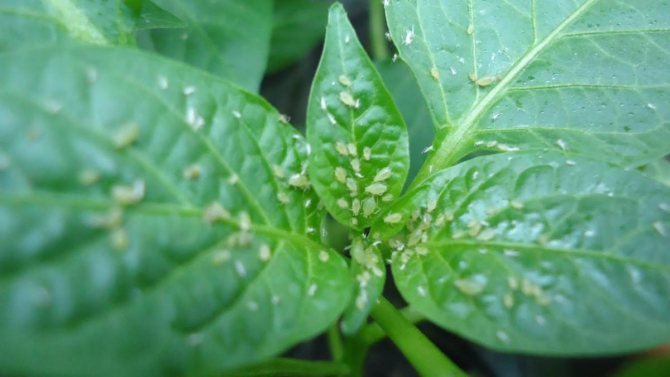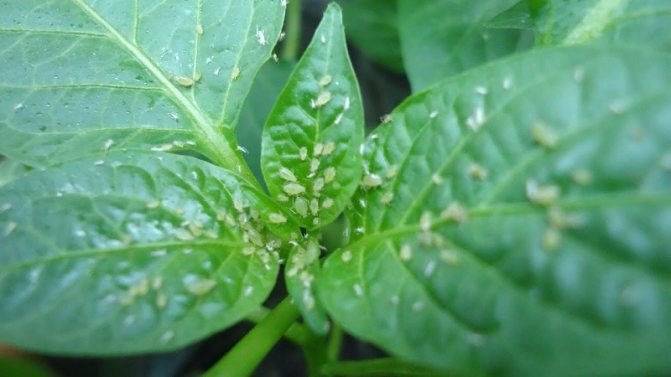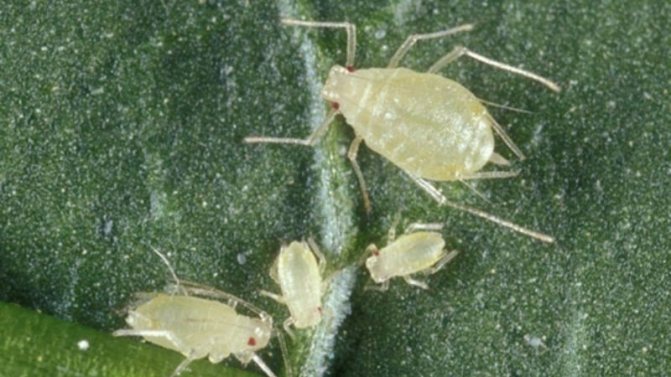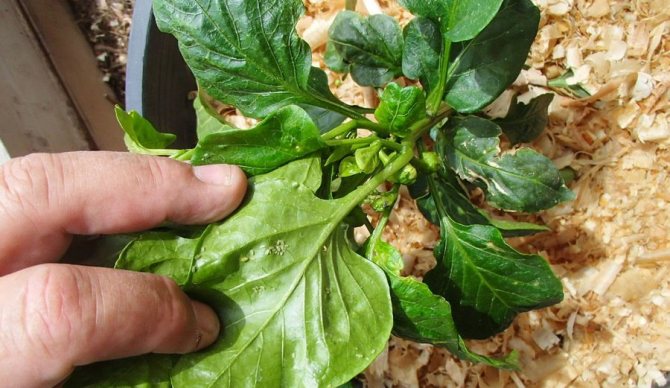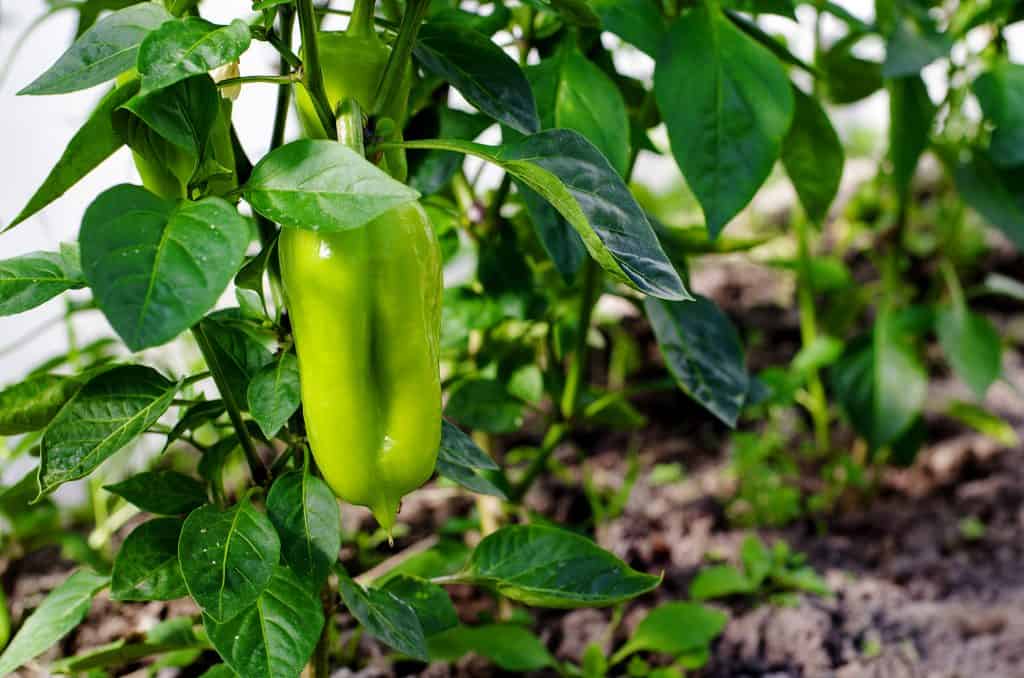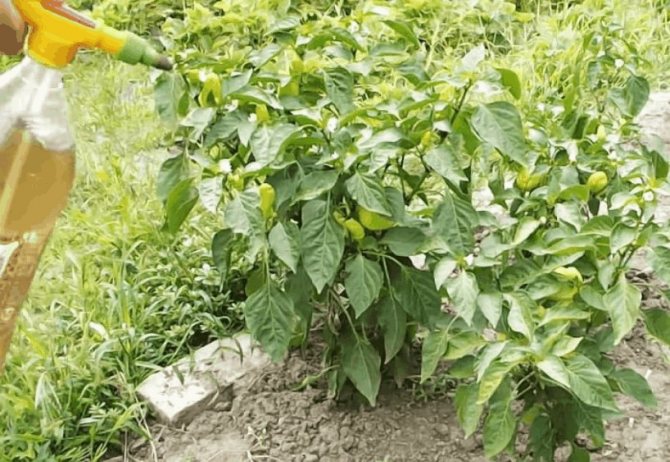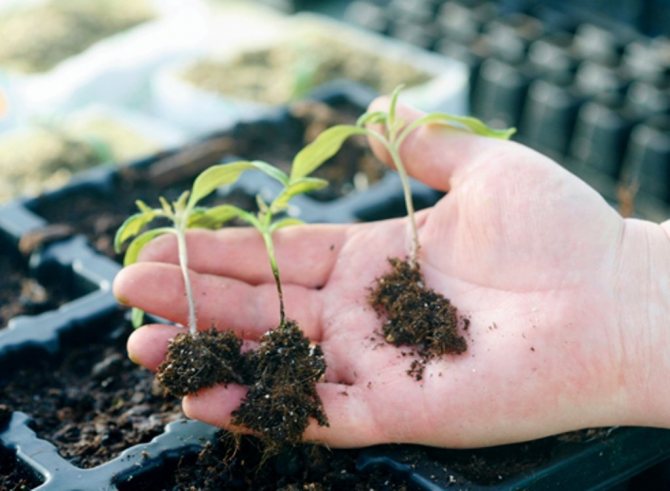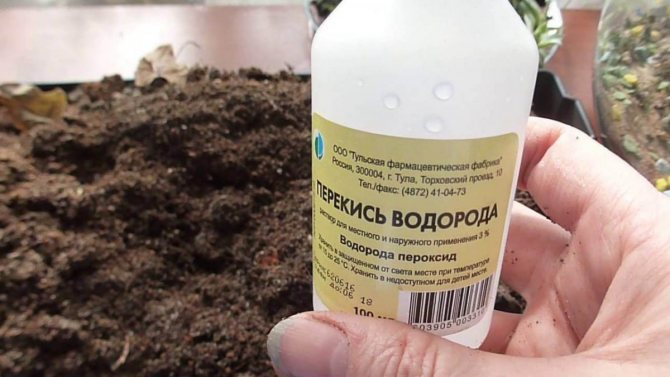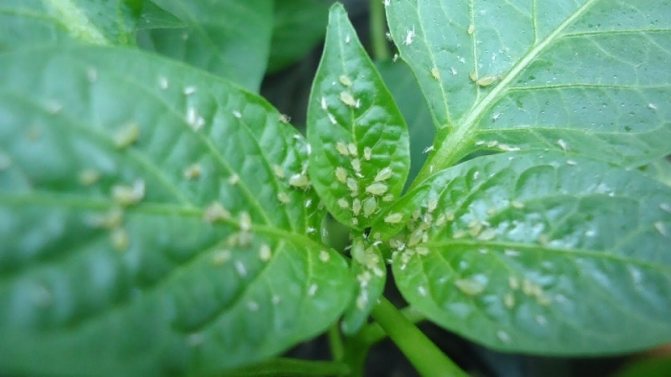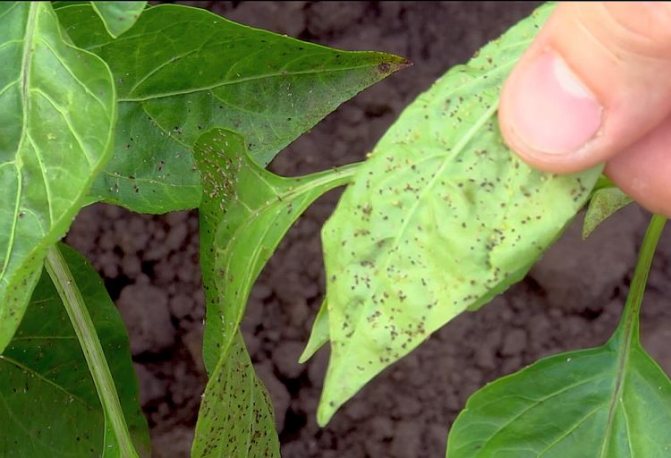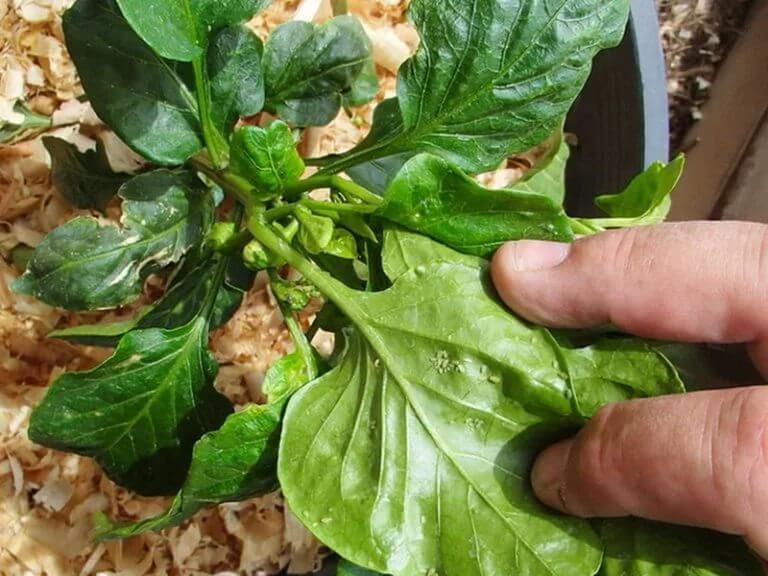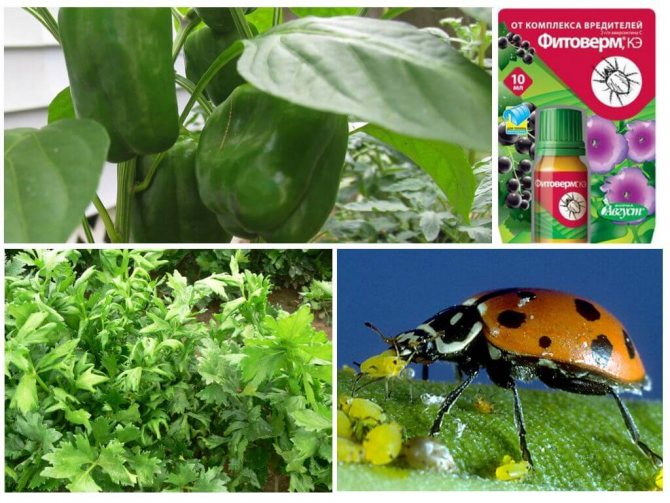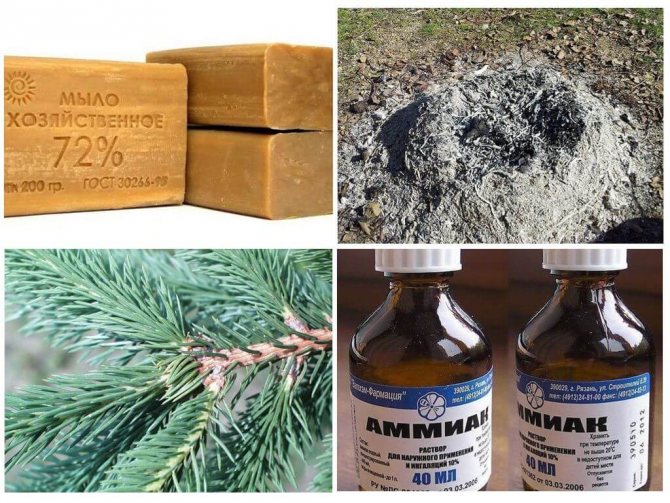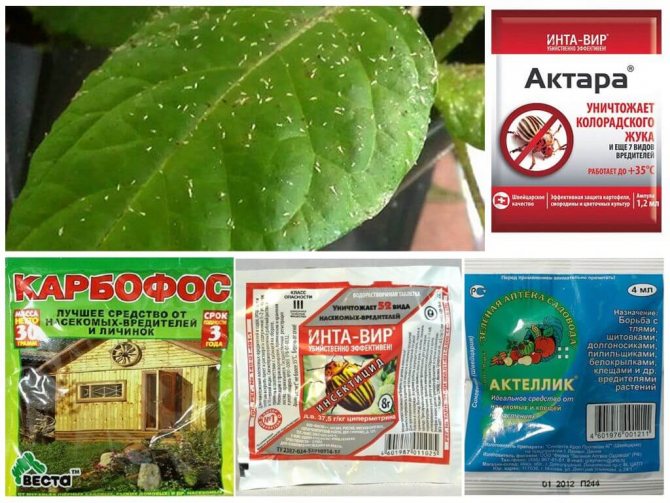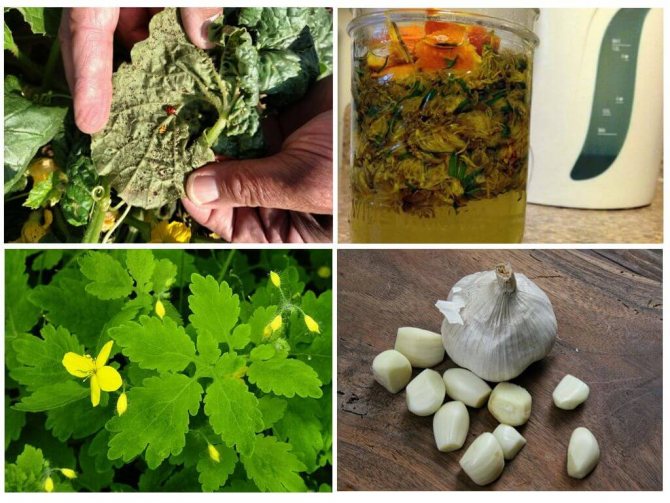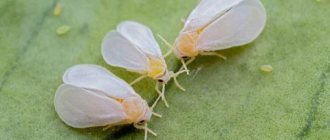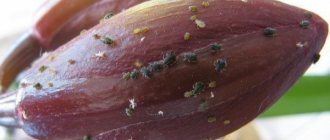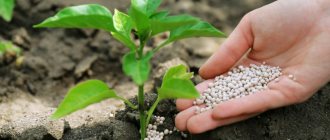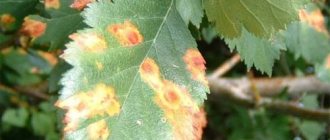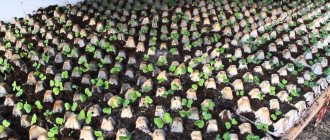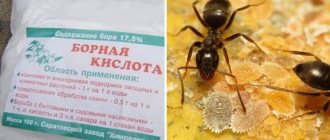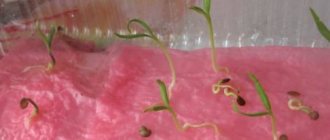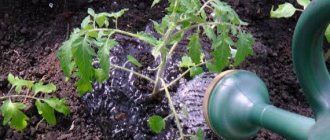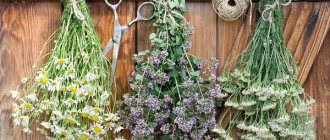Vegetable growing »Pepper
0
1314
Article rating
Every gardener is worried about the pest situation when growing vegetables. Even if the plant is resistant to disease, there is a chance of infection. Aphids on pepper are common in gardening. These insects suck out juice from vegetables, which slows down its growth.
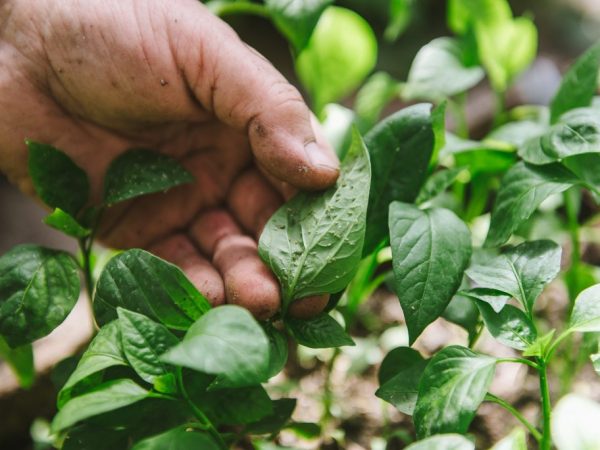
Aphids on pepper
Aphids are caused by ants. They are carriers of pests. You can understand that the plant is infected with these insects by the state of the leaves. They curl, dry out and fall off. From the back they become sticky, aphid larvae are visible on the surface. The fight is carried out by chemical, biological methods. Folk remedies will also help.
Causes of aphids attack on a plant
In the fall, females lay fertilized eggs. They hide them in the bark of plants and shrubs. Ants hide aphid eggs in an anthill for the winter - these are the main guards of aphidids. In the spring, females appear with wings that do not need a male to continue offspring.
Young female aphidids are able to reproduce independently (this method of reproduction is called "parthenogenesis") at an incredible rate. Each of them produces hundreds of larvae. After a couple of weeks, the small larva turns into an adult asexual parasite that reproduces by parthenogenesis.
The reasons for the appearance of aphids on sweet peppers:
- the presence of an anthill on the site or next to the garden;
- the garden is overgrown with weeds;
- a flower bed in the immediate vicinity of the pepper bed;
- soil or seedlings with parasite larvae;
- unfavorable temperature;
- plant roots were overly flooded with water, irregular watering.
Symptoms
Aphid larvae are so small that it is difficult to notice their appearance on plants with the naked eye. Vegetable growers notice the pest when the pepper is already sick.
The first signs of aphidid infection:
- seedlings turn yellow, dry up and die;
- buds fall off, fruit ovaries are not formed;
- the sticky substance covers the surface of the pepper with a thin layer;
- the bush shines and becomes sticky to the touch;
- small, creeping parasites cover the seamy side of the leaf;
- the growth of the plant stops.
Pest control must be started as soon as possible, otherwise aphids will destroy the entire crop.
In the fall, female aphids lay eggs fertilized by males. They hide in the bark of bushes, sometimes they are covered by ants along with their clutch. Having survived the winter, the eggs hatch, and winged female aphids emerge from them, which can reproduce without the need for a male. Parthenogenesis - the property of pests to reproduce independently - gives an advantage for the survival of the species and parasitism on cultivated plants.
In addition, the process of population growth occurs at an incredible speed: the number of insect individuals is increasing almost exponentially. One female is able to lay up to hundreds of eggs, each of which produces aphids, which, in turn, also share parthenogenesis.
Direct causes of the appearance of aphids on the site:
- anthill;
- weed;
- the neighborhood of peppers with other flowering plants;
- the presence of aphid larvae in the soil;
- infected seedlings;
- excessive watering;
- wrong temperature conditions.
Types of aphids, and how are they dangerous
Aphids on pepper seedlings are a small insect that parasitizes plants. In nature, there are at least 4000 species, of which about 1000 can be found in the European part of Russia. Among all pests, aphids are especially dangerous, because they have wings, fly from bush to bush, and have protective mechanisms against many insecticides. It settles on almost all fruit and berry crops, indoor flowers.
It is easier to get rid of aphids if they did not appear during flowering or planting seedlings, but on adult plants. Young bushes affected by this insect rarely produce a crop, since there are no high-quality ovaries and further fruits. In addition, the larvae grow rapidly, the number of insects increases exponentially.
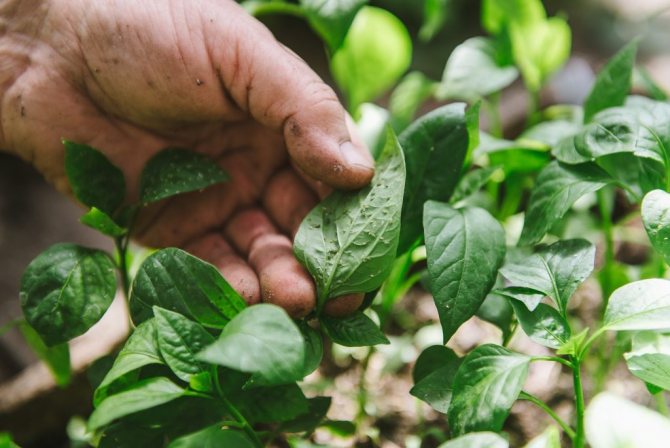

Bell pepper affects 2 types of aphids:
- Green. It thrives in large colonies, mainly during the flowering period. A small green insect appears on seedlings in late spring and early summer, at which time the plant is in an active growth phase. During the summer months, one female breeds several offspring, which suck the juices from the green parts of the pepper. Infection of the plant is difficult to notice, since at first aphids appear in small numbers and settle mainly in places where the leaves are attached to the stem. Signs of infection are abnormally developing buds and shoots, leaf folding, the appearance of a white bloom, thinning of the leaf blade, weakening and deformation of the stem.
- Indoor or black. An insect, the size of the body of which does not exceed 0.3 mm, is practically invisible to the eye. The color can be different, but mainly black-colored insects parasitize on bell peppers. It settles on the underside of the leaves and on the trunk. It feeds on the juice of young leaves, shoots, which are rich in amino acids and carbohydrates. In front of the aphid's body there is a special proboscis, which allows you to bite through the thick skin of the leaves and extract juice. First of all, the strongest succulent plants are affected, on which the female lays offspring for the winter. When pepper leaves are punctured, bacteriosis develops, causing rotting, the growth and nutrition of the plant is disrupted. The bush dies before the beginning of fruiting.
This insect settles not only on pepper, but also on many crops in the garden. It can infect roses, cabbage, tomatoes. In the early stages of infection, chemical treatment methods are used that instantly kill all offspring. Before the start of budding, more gentle methods are used that do not affect the growth rate and quality of future fruits.
During fruiting, aphids damage the buds, they fall off. Adults and their larvae, sucking the juice, weaken the peppers. The sticky pad that covers the leaves interferes with the process of photosynthesis. It serves as a breeding ground for pathogenic fungi.
A large colony of aphids can leave a summer resident without a crop. The development of the peppers stops. Part of the ovaries falls off. The fruits are not poured, they are few, their shape is deformed. Any change in the weather can cause illness. Without timely treatment, the pepper bush affected by aphids may die.
Signs of the presence of an insect
The most budgetary are folk remedies and methods for processing pepper, which will not only get rid of aphids, but will also be effective against other pests. Ready-made insecticides are also very popular - preparations for insects that settle on fruit and vegetable crops.
Biological agents are also popular today, because they gently fight aphids on peppers in the greenhouse and in the garden. The essence of the method is to attract insects and birds to the site that eat aphids, but do not harm garden crops.
Chemical
Even a novice gardener can fight aphids on pepper seedlings with the help of modern insecticides.The following drugs are most effective in the fight against aphids:
- Spark. Quite toxic insecticide. The solution diluted according to the instructions must be sprayed with pepper. You can also use this treatment method for prophylaxis.
- Dichlorvos. Dangerous for inflorescences and leaves, as it contains substances that leave burns and lead to the death of the plant.
- Fitosporin. A modern chemical remedy for aphids, has an antibacterial and fungicidal effect. Protects not only from insect pests, but also from various diseases that they carry. Available in suspension, powder and paste form.
- Kortlis. Systemically affects parasites and their larvae. The effect of the treatment lasts 21 days, then the spraying must be repeated. The concentrate is diluted in water.
- Intavir. It affects the nervous system of insects, as a result of which they die. Creates a protective film on the surface of plant tissues, which is poisonous to bugs. It is produced in the form of tablets, powder, which are diluted in water and used for spraying.
- Commander. Effectively fights many insects and larvae. The active substance is resistant to sunlight and water washout, therefore it is used outdoors.
- Copper sulfate. It is produced in the form of blue granules. First, a paste is prepared from them, which is then mixed well with a solution of water and potassium permanganate of a slightly pink hue. It is used not only for spraying, it is used to cultivate the soil around the bushes.
- Aktara. For 1 liter of water, 5 g of powder is used. It is widely used to combat the Colorado potato beetle, but it is also effective against aphids.
- Tanrek. Used in greenhouses and garden beds, it is able to overcome the plant tissue barrier and accumulate in the soil.
Most insecticides today are absolutely safe for humans and animals, accidentally or deliberately eating the leaves and fruits of plants. However, when working with drugs, it is necessary to use protective equipment so that the active substances do not get on the mucous membranes and do not cause burns.
Dichlorvos Fitosporin Inta-vir Spark Commander Copper sulfate Tanrek Aktara Kortlis
Biological
Biological methods of processing aphids on pepper - planting plants that repel parasites, attracting insects and birds that eat aphids.
Such plants get rid of bugs:
- dalmatian chamomile;
- onion;
- garlic.
Blooming plants attract insects, so you can plant them away from the beds:
- mallow;
- nasturtium;
- begonia;
- viburnum;
- Linden.
When creating such protection for the pepper crop, it is necessary to remember about the safe use of insecticides with which the bushes are treated. The prepared solution must be applied carefully, otherwise birds and ladybugs can eat bugs treated with chemicals and die.
Folk
It is safer to use folk remedies - they do not harm a person when eating fruits. The following methods are used:
- Soapy water. Take 2 pieces of laundry soap and 10 liters of water, rub the bar, dissolve in warm water. Spray all parts of the bush with the solution.
- Garlic, onions. Peeled vegetables are passed through a meat grinder, then 300 g of gruel is poured with one liter of water and insisted for three days. This concentrate is diluted in a proportion of 30 g per ten-liter bucket of water.
- Dandelion. Add 0.5 kg of roots and 1 kg of green leaves (crushed) to 10 liters of hot water, leave for 6 hours. Add 15 g of shavings of laundry soap, dissolve and use for spraying.
- Burdock soap. To prepare the solution, use 3 cups of chopped leaves, which are infused in a 10-liter bucket of warm water for at least 2 days. Then it is stirred with 40 grams of soap shavings, used to spray pepper.
Also, in order to protect against pests, you can plant flowering plants with a sweet smell and a lot of nectar next to the bushes, which will attract the attention of insects.
The leaves of young sweet pepper turn yellow and curl, after which they simply fall off. Why is this happening? The fact is that aphids feed on plant juices with nutrients, which is why the planting itself does not have enough of them. Young seedlings are especially susceptible to this, whose root system did not have time to develop to the desired level and cannot cope with the unexpected load on their body. Young shoots may well wither and die completely.
We suggest you familiarize yourself with: Black sewer cockroaches
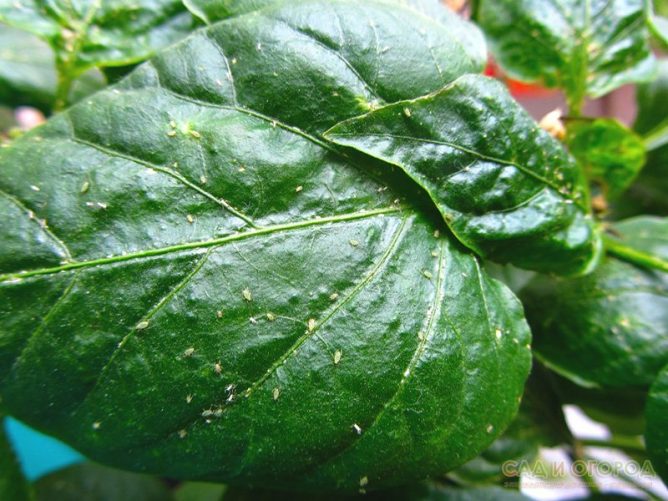

A small seedling will die, but an adult and healthy plant will survive the attack of aphids and stoically continue to reach for the sun. All the nutrition obtained with the soil and fertilizer will go to support life - roots, stem and leaves. But the culture must give birth - to bloom and form a fruit. Because of the aphids, the pepper does not have enough resources for it, so the already grown inflorescences fall off and crumble.
Another sign of the appearance of parasitic insects on young sweet peppers is the indispensable appearance on the stem of a liquid and viscous substance, which is popularly called padya. In fact, this is a very multifaceted phenomenon, because:
- on the one hand, it is a nutrient for ants, because of which the latter enter into symbiosis with aphids and protect these insects from others, such as ladybugs and Colorado beetles;
- on the other hand, honeydew is a good breeding ground for the development of molds. Their presence on a plant is an almost one hundred percent guarantee of the development of mold mycoses, because, unlike animals, green spaces do not have an immune system. Without human help, the culture of pepper affected by the fungus dies.
The proximity of nutritious resources, shelter from rain, wind and sun, protection by ants from natural enemies - all these are reasons for the settlement of aphids in pepper for a long time. Here, the pest will multiply and lay eggs. One female produces up to one hundred eggs in her life, they are formed into a clutch that is quite convenient for guarding. One tiny egg is difficult to distinguish with the naked eye, but their cluster becomes more noticeable.
In addition, if aphids parasitize on a plant for a long time, the latter structurally changes:
- the "immunity" of culture is undermined, if you can call it that. The plant is less tolerant of other types of diseases;
- "sooty" molds join the insect parasitism;
- the shape of the shoots changes.
You need to carefully examine the leaves on the pepper seedlings. Aphids on peppers in a greenhouse or in a vegetable garden give themselves away by characteristic features:
- leaves began to curl and dry on the shoots. This is an indicator that the aphid that has appeared is drinking the sap of the plant;
- whitish blotches of honeydew appear on the leaves, which are emitted by aphids;
- pepper becomes covered with thick sticky mucus, which shines when exposed to sunlight;
- if you peel back the edge of the affected leaf and look at its back side, you can see adult insects and their eggs.
After it became obvious that there are aphids on pepper seedlings, you need to choose the most acceptable method of dealing with it.
What varieties can be found on the vegetable?
Today, on average, five main types are known: nightshade, greenhouse, peach, green and black aphid. It should be noted that the last two insects are considered the most dangerous: they not only parasitize the plant and feed on its vital juices, but also produce a substance that is a breeding ground for fungi.
Green
Green aphids settle in large colonies on young pepper seedlings. A distinctive feature of this species is the love of flowering shoots.That is, by the end of spring, insects climb the stems and leaves of the plant, but aphids begin their violent reproduction closer to the phase of budding and fruiting. Until this time, it is difficult to notice them, since the main group of insects hides at the place where the leaf is attached to the stem.
Black
The black aphid, she is also indoor, is the smallest insect - a representative of the family. Small, no more than 0.3 mm in size. It is customary for black aphids to dwell on the stem and the inside of the leaves of young pepper. Nutrition mainly comes from the nutritious juices of the plant, and the most important elements in the aphid's diet are carbohydrates and proteins, broken down into amino acids.
That is why it is not surprising at all to notice this parasite on young shoots. In addition, in the course of digestion, the aphids excrete "honeydew", which tastes sweet and attracts ants. Most often, these two types of insects work together, therefore, where aphids appeared, ants will soon appear, and vice versa.
Peach
A small, oval-shaped insect. Larger than black aphids: 1 to 2 mm in size. Like other species of this family, the peach aphid appears, reproduces and makes clutches on the inside of the pepper leaf, but differs in appearance - the integuments of the insect's body are painted in red and orange tones.
Greenhouse
The third largest aphid, its body length ranges from 2 to 3 mm. Outwardly, the insect looks more like a green variety, but the size characteristic turns out to be a decisive difference. The main feature of the greenhouse individual is that it is extremely thermophilic. The favorite nesting place of this parasite is greenhouses, therefore, it will not spread to cultivated plants outside the greenhouse.
Nightshade
The largest insect of the whole family: the average size is 4 mm. The body of the nightshade aphid is covered with light green chitin, however, this pest hardly differs from other species in its behavior.
Harm
Aphids are capable of completely destroying the plant. These insects can harm in two ways:
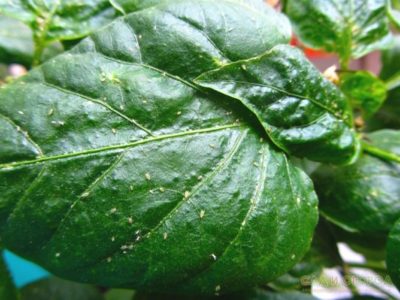

Sucking out juice during nutrition - the whole cellular structure is disturbed. The plant slows down in growth, and then stops growing altogether.- The honeydew also has a negative effect on the plant - the very substance (milk) that forms the aphid, and which attracts the attention of ants. Such milk is obtained by processing the excess amount of juice sucked from the plant.
In general, pad is harmless for pepper bushes, but its accumulation in large volumes leads to a number of unfavorable moments:
- Pad - extremely sticky, a large amount of it, covering the entire sheet, leads to the accumulation of dust on it.
- Formation of black mold - the reason for this is the excessive sweetness of the honeydew. The formation of black mold, combined with a large amount of dust on the leaves, leads to a lack of sunlight and a decrease in the productivity of photosynthesis.
The damage is caused by aphid saliva, which contains toxic substances that damage the leaves of the plant. It can also contain various viruses that plants transmit to each other. And in this case, not only pepper can suffer, but all plants growing nearby. More details about what aphids eat in nature can be found in this material.
Biological impact
The easiest way to regulate the aphid population is to manually remove the insects from the affected leaves. You can use a jet of cold water for this purpose. It is also advisable to remove leaves affected by aphids.
Unfortunately, this method does not completely eliminate the parasite. Aphids on pepper seedlings breed at an incredible speed, and no one has enough time and energy to inspect all the plants every day. Insects and their clutches fall into the ground, from where they again climb onto plants and begin their harmful activity.
Important! Aphid eggs can be preserved in the soil for up to two years.
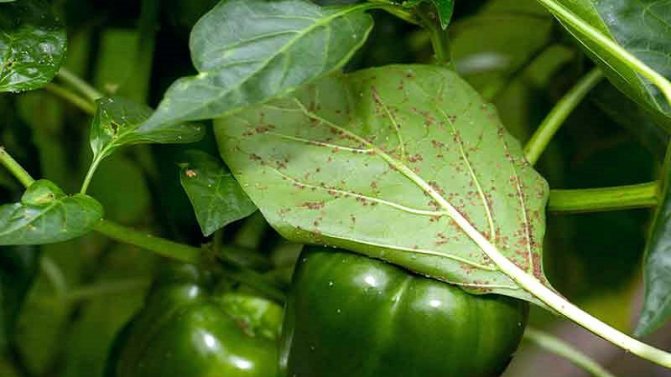

The pest has many natural enemies, both among birds and among insects. This can be used if you attract them to your site using baits. The following predators will help to destroy aphids.
Among birds, aphids are exterminated by tits, wrens, warblers, linnet, kinglets and sparrows. In order for them to visit your garden more often, you need to place feeders, drinkers with water and bird houses in the immediate vicinity of pepper seedlings.
Insects that fight aphids most effectively are the May bug, wasps, ladybugs, predatory bugs, ground beetles, and lacewing. For them to appear in the garden, you need to plant plants in the garden from which a spicy smell emanates. Such plants include parsley, dill, cloves, nettles, carrots.
The regulation of the pest population through biological action allows you to control aphids on pepper both in the garden and in the greenhouse. However, for this mechanism to start working, you need to spend a lot of time on preparation. Therefore, it is necessary to plan its introduction long before the pepper is planted in the ground, otherwise the aphids will have time to destroy the crops with complete impunity before the start of fruiting. In addition, this method works only on open ground, greenhouse crops do not allow it to be used.
Important! Bioinsecticides are an effective way to control aphids.
The most effective way to remove annoying aphids from an area with sweet peppers is to fill its ecological niche with other insects.
In addition to insects, you can attract birds to work - sparrows and tits. Insects are natural food for them in the wild. Birds do not eat ladybirds, which are also antagonists of aphids in the wild.
An excellent solution would be to grow plants with a pungent insect repellent smell:
- nasturtium;
- chamomile;
- onion;
- garlic;
- Linden;
- begonia;
- viburnum.
We suggest that you familiarize yourself with: How to effectively poison cockroaches
How can an invasion be dealt with?
Most people have no idea how to get rid of aphids on peppers. It is not difficult, there are many ways to control insects - from the ability to treat at home to professional chemical and biological insecticides. Periodically, a complex of works is carried out at once, combining different possibilities.
Some of them are less effective, others are more. Usually, two or three treatments of the plant against insects are carried out at regular intervals. If aphids on pepper seedlings have filled a large number of young seedlings, then the most suitable way would be to use Dichlorvos from insect pests.
Prophylaxis
Prevention is the most effective method of dealing with aphids... This is painstaking, systematic work, but the time spent will pay off with an excellent harvest. It is always easier to prevent a problem than to deal with it.
Preventive measures used in the fight against insect pests:
- disinfection of seeds (treatment with a solution of manganese with garlic) and soil - warming up (freezing) the soil;
- tillage on the site - weeding out and digging, processing with garlic infusion;
- fighting ants on the site;
- manual collection and destruction of the pest.
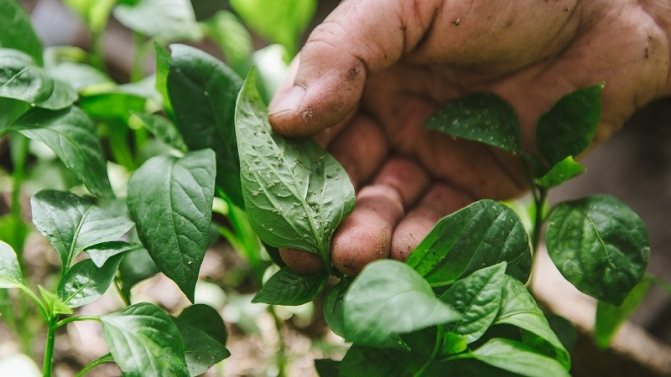

As a preventive measure, the condition of the site is monitored, weeds and dry grass are removed in time in the fall. Buy seedlings only from trusted sellers. Areas of plants that have been damaged by aphids are removed daily.
Important! Timely watering is a prerequisite for pest control.
How can aphid seedlings be treated for preventive purposes? Summer residents often use onion and garlic tincture, since a specific smell scares off aphid larvae.
Folk remedies to combat aphids
The key to using chemicals is to spray them outdoors.Plants in the greenhouse will not be affected, however, it is required to isolate agricultural productive animals and insects from the direct and indirect effects of insecticides.
Karbofos
Karbofos is a popular and long-established product on the market that can be used to fight aphids at home. The product is sold in the form of a powder in a plastic bag. It is diluted with water in the proportion of one tablespoon of the substance per liter of water. An important feature: processing with Karbofos is carried out before the beginning of flowering of sweet pepper, otherwise poisonous substances will fall into the fruit that forms on the shoot of the plant. Such peppers will be unsuitable for food.
Fufanon
The second most effective means of fighting not only aphids, but also other parasitic insects, is Fufanon. It works faster than any other treatment chemical, however, it is just as toxic as Karbofos.
Aktara
Mainly used for processing young plants. Aktara is produced in vials with a viscous concentrated liquid, which is diluted in a ratio of 5: 10000. That is, only 0.5 ml of the active ingredient is needed per liter of liquid. A systematic approach is needed, the processing of plants is carried out at intervals of three days during the week. After that, all aphids are removed without a trace.
If you do not complete the course of treatment, parasitic insects can become resistant to this type of chemical.
Another chemical suitable for the processing of vegetables and fruits. The toxins in its composition pass into the fruit, therefore it cannot be used on plants during flowering and fruiting. During this period, it is worth using non-chemical methods of dealing with parasitic insects.
Intavir
This drug is made in tablets, therefore, it makes no sense to dilute to a certain extent. One tablet is dissolved in 10 liters of water. Depending on the scale of the disaster, two may be needed. You need to process it twice, in a week. Intavir is multi-tasking: it also destroys the Colorado potato beetle.
Actellic
Liquid toxic substance that acts on insects through the gastrointestinal tract. It is produced in ampoules with a volume of two ml, which are diluted into two liters of liquid. It is important to use it away from apiaries, as bees are insects too.
Powdered insecticide. The solution is diluted according to the instructions on the package. The resulting mixture is sprayed onto the planting once.
Tanrek
It accumulates in the soil, which is why one treatment is enough for plants for a long period of time.
Chemicals are not always safe to use. What if the plant has already entered the flowering stage? Folk remedies can help from aphids on the peppers themselves. But do not believe everything that word of mouth carries.
Laundry soap
Laundry soap is rubbed on a grater, dipped in a bucket of hot water and wait until it is completely dispersed, forming a homogeneous soap foam. Starting from the top and gradually moving down, the soapy solution should be sprayed on all the shoots of the plant. If it rains after processing, and the pepper grows outside the greenhouse, then it is necessary to process it again.
Ash and tobacco
A container with a volume of two liters is completely filled with water and three tablespoons of crushed tobacco sheets mixed with ash are diluted in it. The infusion process takes about four days, after which the mixture is filtered through a charcoal filter or gauze bandage and mixed with soapy water.
Spruce needles
Ten liters of water in a bucket is mixed with 1 g of tobacco and 1 g of needles. Similar to the method with ash, mix and insist for three days and filter.
Baking soda does an excellent job with both the onset of an invasion and a full-sized clutch of aphids. Combined with laundry soap in the calculation: one tablespoon of soap 2 tablespoons of baking soda 1 liter of water.
Mustard
Usually, mustard is used in horticulture solely to enrich the earth with nutrients, but it also has a second use. This product is a great help in the fight against insects, including aphids.
Benefits:
- the effect is noticeable after a week;
- low price and availability. Mustard powder is sold in almost any grocery store and is inexpensive;
- duality of use on plants;
- prevention.
Disadvantages:
- with some species of aphids, you will have to "sweat" - repeat the treatment of plants two or three times;
- hydrophobicity. Watering or rain after treatment will negate the effect.
Ammonia
First of all, it should be noted that the essence of the method lies only in the smell of ammonia. It repels insects. If the ammonia drove out the aphids, it will scare away the ladybirds, which might well be useful. A two-way method, which nevertheless will help to process aphids on peppers directly at home - even in a small greenhouse in a small country house.
Hydrogen peroxide
100 ml of hydropyrite per spoonful of alcohol, half a teaspoon of liquid soap and a liter of water. Stir for a long time and gently until the consistency becomes even and uniform, then spray the plants from top to bottom.
Milk and iodine
When using this mixture, it is worth remembering that:
- only fresh mixtures should be used. Milk curdles over time;
- you can overdo it with the concentration of iodine in the solution and burn the greenhouse plant. For the same reason, spraying is carried out under oblique sunlight and never at the zenith;
- skim milk is best.
Coca Cola
At the moment when insects have already filled the garden and greenhouse, and there is no effective remedy like Funanon at hand, every summer resident is trying to solve the problem with improvised materials. One of them was Coca-Cola. The only substance in Cola that can harm insects is phosphoric acid, which is safe for animals.
Garlic
Garlic tincture is primarily a preventive measure, because it repels insects only with its smell. Incomparable to the action of ammonia, so it is best to combine garlic with something more effective.
Celandine
Two bushes of celandine are carefully cut off at the very root, since the juice of this plant is toxic. Avoid contact with exposed skin. Shoots of celandine are crushed with a knife. Leaves clothing stains that are difficult to remove.
After cutting the bushes, you should soak them in a ten-liter bucket of water for three hours. To make the plant infusion better attached to the pepper shoots, you can add a small amount of liquid soap or household scraps to the bucket. Calcium chloride is added to increase the killing effect on insects.
The main active ingredient of vodka is ethyl alcohol. Its effect on insects has not been fully studied, but by analogy with more developed animals, it has been found that C2H5OH acts on the nervous system of insects in the same way. In addition, alcohol gives a bitter taste and a specific repulsive odor to the leaves: the surviving aphids cannot feed and reproduce.
Birch tar
Similarly, birch tar acts on insects, however, you will have to suffer a little with it: get it and dilute it correctly. In addition, this substance also has a pronounced bactericidal effect.
We suggest that you familiarize yourself with: What to do if bitten by a mouse: first aid, the consequences of a bite
Boric acid
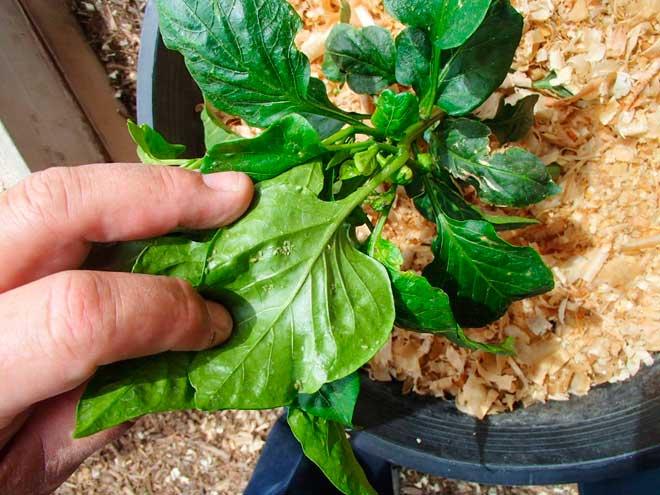

A universal remedy for combating many harmful insects. Boric acid is sold in a pharmacy, after use, the leftovers can be used on the farm. The acid solution is tasteless and odorless, so insects will not suspect danger until death.Another thing is important: the size of the particles dissolved in water is larger than the pores between the chitinous scales of aphids, therefore, the acid will not penetrate the insect's body and will not produce the desired effect and will not save the plant from death.
Biologically active drugs are the safest means to use, since they act pointwise on a specific living organism and do not affect the useful culture.
Fitoverm
It acts in a complex against two insects at once: aphids and ants. The active substance is aversectin C, when it enters the gastrointestinal tract of an insect, it begins to act in a contact way after 12 hours. Pests die in no more than three days.
Due to the mechanism of action, Fitoverm does not act on larvae.
Akarin
The mechanism of action of this drug is based on blocking the absorption of nutrients by the stomachs of insects. Care should be taken to use if bees or fish are in the reach. One treatment is enough at the rate of 6 ml per liter of water.
Boverin
Boverin is developed on the basis of the culture of the mushrooms of the same name. It is used exclusively for greenhouse plants, as its active temperature reaches 25 degrees. For spraying pepper bushes, use a one percent solution. It also destroys bear and Colorado beetles.
To get rid of aphids, you can use any drugs that include a neonicotinoid, pyrethroid or organophosphorus compound. Before using the product, it is important to carefully study the instructions. The fact is that the substances are toxic to humans, and if you fight them with aphids on peppers in a greenhouse, this requires the mandatory use of a respirator. Currently, the following classification of aphid remedies on pepper seedlings has been adopted.
Preventive control methods
After a vegetable garden is infected with aphids, it will not be easy to remove it. Therefore, it is much easier to take action ahead of time to protect your seedling greenhouse than to subsequently try to save a dying crop. Get rid of aphids before planting seedlings using the following guidelines.
Block all paths for aphids to enter the garden or greenhouse. To do this, it is necessary to disinfect it by calcining before introducing new soil. This will destroy the egg clutches of the parasite on the treated crops. Before planting, seeds must be pre-treated with a solution of potassium permanganate and hot water, you can use hydrogen peroxide. All containers and tools for working on the beds must be treated with lime. A soda mixture is also suitable for this purpose.
It is recommended to plant green onion and garlic seedlings around the perimeter of the site in order to repel migratory insects. Then they will not even fly into your area or greenhouse.
If aphids have already been successfully defeated on the territory of the garden, it is important to remove the affected shoots from the ground. We remind you that aphid eggs can be preserved in the ground for up to 2 years, and then the parasite can reappear when favorable conditions occur.
Preventive measures
To avoid the appearance of aphids on your beds, you should adhere to the following rules:
- The ideal microclimate in a greenhouse for peppers is 85% humidity and an air temperature of 25 degrees.
- Regular ventilation.
- Constant feeding.
- Fumigation of the greenhouse with warm sulfur gas prior to planting.
- Disinfection of the greenhouse frame with bleach or potassium permanganate solution.
- Regular weed removal.
- Purchase of planting material only from trusted manufacturers.
Reference. Properly cared for plants have good immunity and are therefore more resistant to pests and various diseases.
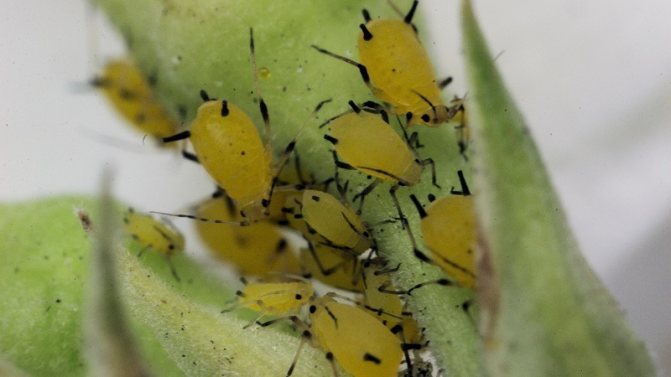

Pest control methods
Aphids are a serious enemy of sweet pepper. What should a gardener do when faced with this problem? There are three methods of dealing with aphidids:
- chemical - quickly gets rid of aphids (cannot be used during flowering plants);
- biological - the natural properties of some species of plants, birds, animals and insects are used to protect plantings from aphidids;
- folk - recipes for getting rid of parasites, which were tested by summer residents on their own experience.
When growing peppers in the open field, it is advisable to lure the enemies of aphids. One week is enough for birds and insects to rid the entire area of it without harming the seedlings. The birds will destroy pests on the site if you create comfortable conditions for them. To attract sparrows and tits to the site, leave them food.
The seven-spotted ladybug larva destroys one hundred adult harmful beetles and up to three hundred larvae in one day. The riders aphelinus and aphidius are the main enemies of the aphids. They lay eggs in the body of aphidids. They feed on aphids and ground beetles, lacewings, earwigs and some species of spiders.
Protect beneficial insects, bring seven-spotted ladybugs, aphelinuses and aphidius to the beds. It is easy to attract riders and hoverflies if you plant herbs in the beds with pepper. First, it is better to study the photos of insects so as not to confuse and not bring pests to the site.
In addition to birds and insects, nature has created plants that are able to fight harmful insects: Dalmatian chamomile, onions, garlic. Plant these plants next to peppers to keep aphids away.
The smell of some spices - carrot tops, dill, parsley - also repels harmful insects.
Chemicals
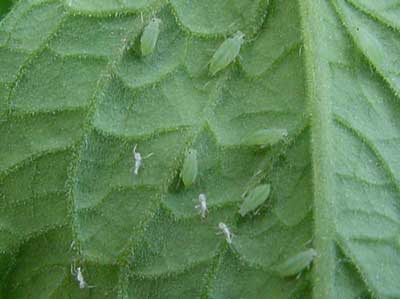

To combat aphids, insecticidal and organic chemicals are produced. How to treat pepper from aphids during fruiting? In this case, the owners of summer cottages use biological preparations for pest control. Their main advantages are that they do not harm the microflora of the soil, and the crop of peppers can be eaten within 24 hours after processing the plants.
Biological means include:
- Akarin. The treatment of a garden with an area of 10 m² will require 1 liter of solution. The effectiveness of the product decreases at temperatures below 18 ° C.
- Fitoverm M is used to combat fungal diseases of plants. The drug is produced in the form of a paste and ampoules. One ampoule is diluted into 4 liters of solution. It only affects adults that die 72 hours after treatment. This drug does not work on larvae. The processing is repeated 3-4 times.
Insecticides work quickly and effectively. Their main advantage is the destruction of parasites in one go. The most effective insecticides contain neonicotinoids and pyrethroids.
Consider the most popular insecticides:
- Plants are treated with the drug "Intavir" in dry weather twice with an interval of 7 days. The drug is available in the form of tablets. The solution is made at the rate of 1 tablet per bucket of water. This amount is sufficient for processing crops with an area of 10 m². The protection is valid for 2-4 weeks.
- "Karbofos" is a contact insecticide. Only those pests that get the solution die. Processing is carried out 2 times with an interval of 10 days. The effect of the insecticide lasts 8-10 days. The solution is prepared at the rate of 1 tbsp. l. "Karbofos" for 10 liters of water.
- "Aktara" is a preparation with contact-intestinal action. The main advantages of this insecticide are that it does not decompose and does not accumulate in the soil, does not cause an addictive effect in insects. The product is produced in the form of 5 ml ampoules. 1 ampoule is diluted in 10 liters of water. Processing is carried out twice at weekly intervals. The drug begins to work in 30 minutes.
Folk remedies
Folk remedies are safe for humans, but to a greater extent they prevent the attack of aphids. Experienced summer residents are advised to deal with aphids using soda, ammonia or hydrogen peroxide:
- hydrogen peroxide - mix 50 ml of hydroperite, 2 tbsp. l. medical alcohol, 0.5 tsp. liquid soap and 900 ml of water, spray the plants;
- ammonia - prepare a solution at the rate of 20 ml of ammonia per 10 liters of water, spray it on the plants (ammonia repels pests with a smell);
- baking soda - make a solution at the rate of 1 tbsp. l. grated laundry soap and 2 tbsp. l. soda in 1 liter of water, spray pepper bushes.
What means to choose for open ground, and what for greenhouses
The likelihood of aphids appearing in the greenhouse is high. No less than outdoors. Winged females get inside during airing and begin to lay eggs on greenhouse plants. The second way of infecting peppers is by ants. They transfer the eggs of the pests to the nest in the greenhouse.
Chemicals are used for aphids in exceptional cases when all other methods are powerless. Usually the fight takes place according to the following scenario:
- mechanical destruction of pests when inspecting bushes;
- every 2-3 days, washing the leaves with water, spraying with a folk remedy;
- spraying the bushes with a solution of Fitosporin-M or Akarin.
Chemical preparations "Karbofos", "Intavir", "Fufanon" are used if more than 25% of plants are infected and all other methods do not help. Chemistry treatments are carried out once every 7 days. The means are alternated so that addiction does not arise.
In the open field, the fight is organized according to the same plan. There are more insecticides from aphids for the garden than for closed ground. You need to read the instructions before using any drug. Folk remedies for aphids are used without restrictions in the garden and greenhouse.
It is necessary to fight aphids on peppers in a greenhouse using the same means as in open beds. Spraying is carried out at any time immediately after the detection of pests.
A beetle on a pepper in a greenhouse can settle on the back of the leaves. Therefore, for processing, it is necessary to use a device with a flexible spray that covers all parts of the plant.
It takes time for all insects to die. But if after 2 days there are still live individuals, repeat the treatment.

